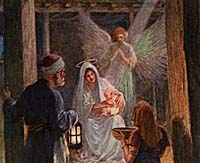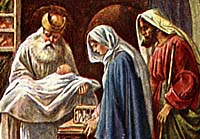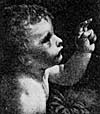
What are some of the most common misconceptions about Jesus’ birth?
See this page in: French, Portuguese
The typical story we hear repeated is:
“It’s about 2000 years ago, the evening of December 25. Mary rides into Bethlehem on a donkey, urgently needing to deliver her baby. Although it’s an emergency, all the innkeepers turn them away. So they deliver baby Jesus in a stable. Then angels sing to the shepherds. Afterwards, they all join three kings with camels in worshipping the quiet, newborn.”
The problem is, this story may be almost entirely wrong. The events surrounding the birth have been retold so many times and in so many ways—in plays, poetry, books and movies—that most people have a distorted view of the true events. The only accurate record is found in the Holy Bible, God’s Word.
-

Did Mary ride a donkey to Bethlehem? Perhaps, but there are various other possibilities. The Bible doesn’t say how she got to Bethlehem. It only says that she came with Joseph.
-
Did Mary arrive in Bethlehem the night she gave birth? The Bible does not suggest this. They could have arrived weeks earlier. God’s Word simply states, “while they were there [in Bethlehem], the days were accomplished that she should be delivered” (Luke 2:6). Arriving in town well before her due date would make more sense.
-
Did Joseph or Mary talk to any innkeepers? Perhaps, but there is no solid, biblical reason to believe that they did. Although innkeepers play a prominent part in many Christmas plays, no innkeeper is actually mentioned in the biblical record of Christ’s birth. Furthermore, it is likely that Mary and Joseph actually stayed in a house with relatives, not behind some kind of Bible-times hotel. (See below)
-
Was Jesus born in a stable? Or a barn? Or a cave? The Bible does not mention any of these three places in connection with Christ’s birth, only a manger. Scripture simply reports that they laid Jesus in a manger because there was no room for him in the guest room. The Greek word used in Scripture is kataluma, and can mean guest chamber, lodging place or inn. The only other time this word was used in the New Testament, it means a furnished, large, upper story room within a private house. It is translated guest chamber, not inn (Mark 14:14-15). According to our Bible archaeology experts, Jesus was probably born in the house of relatives, but outside (under) the normal living and guest quarters. (Learn more: Was Jesus born in a stable? / What is a manger? / What is an inn?
-
“Away in a manger the baby awakes, but little Lord Jesus, no crying he makes.” Although this is part of a beautiful song, we cannot be sure that Jesus did not cry. The Bible does not report this, nor is it likely to be true. It is necessary for babies to indicate their needs and discomforts.

-
Did angels sing to the shepherds outside of Bethlehem? Perhaps, but the Bible doesn’t specifically say that the angels sang. It says that first an angel appeared and spoke, and then appeared “a multitude of the heavenly host praising God” (Luke 2:13).
-

Were angels present at the birth? It seems logical to assume that they were, however, Scripture does not report it, and there is no evidence that angels were visible to Mary and Joseph at this time.
-
Did three kings riding camels come to Jesus’ birth? The Bible does not say that any kings or camels visited young Jesus.

It does report wise men (“magi”) came, but it does not say how many. None of the early Church Fathers, suggested the magi were kings. Since the word “magi” used in the Bible is plural, there were apparently at least two, and there could have been more—even several more. The Bible simply mentions three costly gifts they presented—gold, frankincense and myrrh, but this does not necessarily indicate the number of magi. There is also no proof of what country these men came from.
 Before the arrival of the magi in Bethlehem, Jesus traveled to and from Jerusalem for presentation in the Temple (Luke 2:21-22).
Before the arrival of the magi in Bethlehem, Jesus traveled to and from Jerusalem for presentation in the Temple (Luke 2:21-22).Also, the wise men clearly did not visit Jesus when he was still lying in the manger, as is commonly shown on greeting cards and in plays. The magi did not arrive until sometime after Christ’s presentation in the Temple in Jerusalem (Luke 2:22-39).

At this time, Scripture calls Jesus a “child,” not a “baby.” It is possible that little Jesus was walking and talking by then. Based on the calculations of King Herod and the magi (Matthew 2:16), Jesus could been two years old or under. [Learn more: About the “wise men” (magi)]
-
Was Jesus born on December 25, or in December at all? Although it’s not impossible, it seems unlikely. The Bible does not specify a date or month. One problem with December is that it would be unusual for shepherds to be “abiding in the field” at this cold time of year when fields were unproductive. The normal practice was to keep the flocks in the fields from Spring to Autumn. Also, winter would likely be an especially difficult time for pregnant Mary to travel the long distance from Nazareth to Bethlehem (70 miles).
“A more probable time would be late September, the time of the annual Feast of Tabernacles, when such travel was commonly accepted. Thus, it is rather commonly believed (though not certain) that Jesus’ birth was around the last of September. The conception of Christ, however, may have taken place in late December of the previous year. Our Christmas celebration may well be recognized as an honored observation of the incarnation of ‘the Word made flesh’ (John 1:14).”
“…The probability is that this mighty angel, leading the heavenly host in their praises, was Michael the archangel; this occasion was later commemorated by the early church as Michaelmas (‘Michael sent’), on September 29, the same as the date of the Jewish Feast of Tabernacles. It would have at least been appropriate for Christ to have been born on such a date, for it was at His birth that ‘the Word was made flesh and dwelt (literally tabernacled) among us’ (John 1:14).
This would mean, then, that His conception took place in late December. Thus, it might well be that when we today celebrate Christ’s birth at what we call Christmas (i.e., ‘Christ sent’), we are actually celebrating His miraculous conception, the time when the Father sent the Son into the world, in the virgin’s womb.
This darkest time of the year—the time of the pagan Saturnalia, and the time when the sun (the physical ‘light of the world’) is at its greatest distance from the Holy Land—would surely be an appropriate time for God to send the spiritual ‘light of the world’ into the world as the ‘Savior, which is Christ the Lord’ (Luke 2:11)” [Dr. Henry M. Morris, The Defender’s Study Bible (notes for Luke 2:8,13)].
(The word “Christmas” means “Christ mass,” a special celebration of the Lord’s supper—called a mass in the Roman Catholic Church and a Communion supper in most Protestant churches.)
-
Why do many Christians celebrate Christmas on the 25th of December, if that is not when he was born?
The date was chosen by the Roman Catholic Church. Because Rome dominated most of the “Christian” world for centuries, the date became tradition throughout most of Christendom.
The original significance of December 25 is that it was a well-known festival day celebrating the annual return of the sun. December 21 is the winter solstice (shortest day of the year and thus a key date on the calendar), and December 25 is the first day that ancients could clearly note that the days were definitely getting longer and the sunlight was returning.
So, why was December 25 chosen to remember Jesus Christ’s birth with a mass (or Communion supper)? Since no one knows the day of His birth, the Roman Catholic Church felt free to chose this date. The Church wished to replace the pagan festival with a Christian holy day (holiday). The psychology was that is easier to take away an unholy (but traditional) festival from the population, when you can replace it with a good one. Otherwise, the Church thought it would have left a void where there was a long-standing tradition, and risked producing a discontented population and a rapid return to the old ways.
The various misconceptions about Christ’s birth illustrate the need to always test everything we hear against God’s Word, no matter what the source. The Bible is the final authority.
Despite human misconceptions, the actual facts about Jesus are more marvelous than words can express. He was indeed born of a virgin in the city of Bethlehem exactly as prophecied many years before. Jesus was conceived in Mary, not by man, but by the Holy Spirit of God. As the apostle John reveals, Jesus existed before the Creation of the world (John 1). He is part of the Holy Trinity we know as God (Father, Son and Holy Spirit). The Son of God came in human form for a purpose—to die as a willing sacrifice in payment for the sins of mankind. He did this to provide eternal salvation as a free gift to all who will accept it and follow Him.
Learn much more about Jesus Christ’s purpose and life by reading the Bible (see especially Luke 2:1-20 and the book of John). Also, watch our free online motion pictures about Jesus—The HOPE or God’s Story. Journey back to the true beginning of Christ’s story, in Genesis, and then proceed in chronological order through the exciting, key events preceding His birth—and then on through his life, death, resurrection, and what happened afterwards.
Other common misconceptions related to Christ’s birth
- “There is no archaeological evidence that Jesus or anyone associated with him ever lived. They are all fabrications.” Wrong, see why!
- “The virgin birth of Jesus Christ is mythological and scientifically impossible.” Wrong, see why!
- “All religions are basically the same. So why insist that Christ is the only way to Heaven and salvation?” See why
- Jesus was an only child, and Mary remained a virgin for the rest of her life, even though married to Joseph. Wrong, see why!
- Jesus was genetically related to Mary. See why he probably was not.






